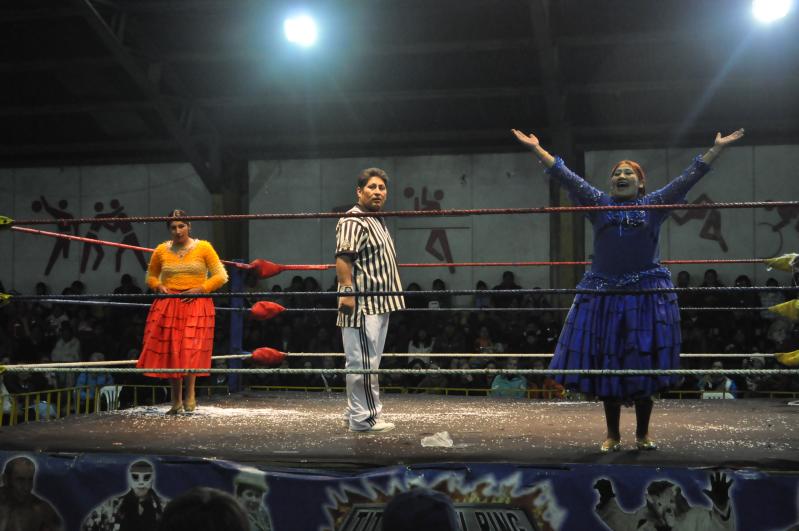The Flying Cholitas Empower Indigenous Women in Bolivia
 At the dawn of the 21st century, women entered the world of Bolivian professional wrestling for the first time. Known as the Flying Cholitas, this group is made up entirely of indigenous women from the city of El Alto. Encapsulating the revolutionary spirit of El Alto, the Flying Cholitas act as positive role models who empower indigenous women.
At the dawn of the 21st century, women entered the world of Bolivian professional wrestling for the first time. Known as the Flying Cholitas, this group is made up entirely of indigenous women from the city of El Alto. Encapsulating the revolutionary spirit of El Alto, the Flying Cholitas act as positive role models who empower indigenous women.
The City of El Alto
El Alto is the largest city in Latin America with an indigenous majority population. Throughout Bolivia’s history, El Alto and its cholitas have been known for their revolutionary spirit. The term “cholita” is derived from “chola,” a phrase used to refer to indigenous or mixed-race women in a derogatory manner. The word “cholita” is now used in a positive light when referring to indigenous women throughout Bolivia.
El Alto, situated on a mountain overlooking Bolivia’s capital, La Paz, laid siege to it in the 1700s. It did so again in 2003, during the Bolivian Gas War, which led to the ousting of then-president Gonzalo Sánchez de Lozada. Afterward, the support of El Alto’s indigenous population saw the first indigenous president, Evo Morales, elected in 2005.
The indigenous population of Bolivia has fallen victim to various forms of institutionalized racism throughout history. They have been denied various civic services, such as the right to vote and the chance at higher education. However, during his time in office, Evo Morales opened government positions to cholitas. As a result, the indigenous women were enabled to play a role in drafting the new constitution. The Flying Cholitas empower indigenous women by embodying this revolutionary spirit of the everyday cholita, making them quite popular.
What is Cholita Wrestling?
When The Flying Cholitas first formed, they served as a novelty act to increase ticket sales for the male-dominated “Titans of the Ring.” Both the male and female acts draw heavily from Mexico’s professional wrestling, known as “lucha libre.” The use of signature moves, entrance music and the hero versus villain dynamic — known as “técnicas” and “rudas,” in this case — display the influence of this format. Fans often join in the fun by jeering and splashing water on “rudas” and cheering for the “técnicas.”
The uniqueness of the cholitas helps attract sizable crowds. The wrestlers’ clothing noticeably deviates from that of “lucha libre” and other professional wrestling formats. Instead of bikinis and spandex, The Flying Cholitas wear clothes similar to ones they wear in the streets and at home. In the ring, the wrestlers will commonly wear bowler hats, long braids, shawls and pleated skirts. Cholitas display these garments to show pride in their heritage and distinguish themselves from the pants-wearing, non-indigenous women.
To become a female wrestler, candidates must undergo a year of training before receiving their certificate. In addition to allowing them to fight, the certificate is a symbol of pride: proof that they can earn money through skill and hard work.
Gender in Bolivia
Bolivia has the highest rate of domestic and sexual abuse in Latin America. In 2015, 70% of women reported having faced some form of physical or psychological abuse. The lack of financial opportunities for women often causes them to stay in these harmful relationships.
The original Flying Cholitas were abuse victims who joined the sport as an outlet for their anger. Now, these wrestlers empower indigenous women in similar situations. The wrestling matches provide a public space to witness the strength of women, especially in mixed matches where women battle men. However, the cholitas had to fight outside of the ring as well to gain more equality in the sport.
When the Flying Cholitas first started wrestling, they were unpaid and barred from using the locker room. As their popularity grew, the female wrestlers gained greater autonomy. They formed the Association for Fighting Cholitas. This allows them to organize their fights and use the facilities. Furthermore, the Flying Cholitas are now paid for their work, around $20-$25 per match. This extra income helps the wrestlers put their children through school and grants them greater freedom from their husbands.
After 20 years, the popularity of the Flying Cholitas has spread, with hotels in the area offering packages that include tickets and transit to their shows. The Flying Cholitas even travel throughout Bolivia to bring their rowdy fights to the masses and empower indigenous women across the nation.
Overall, the Flying Cholitas are a powerful influence in changing the perception of indigenous women in Bolivia. Hopefully, this group will continue to have a significant impact in the coming years.
– Riley Behlke
Photo: Flickr
